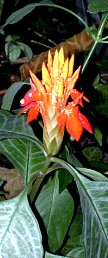 |
|
The Best of the Rest
Items of news or research that should not be missed
And You Thought You
Knew Your Plants!
Rolling Stone reports that Dr. David Scott of Sussex University was able to stimulate growth of plants by playing music to them. Best results came from Meatloaf's album 'Bat out of Hell. ' A Rachmaninoff piano concerto was second best. [Your editor is sadder, and perhaps wiser at the news.]
Silicon as an Element of Fertilization
In spite of the fact that Silicon (Si) is known consistently to be a major inorganic constituent of plants, and even with the knowledge that it is the second most abundant element on the surface of the earth, it is not included in the list of elements that are known to be essential for plant growth.
Evidence has been accumulating that silicon improves the growth of a wide range of field crops, from rice and sugar cane to strawberries and tomato. Scientists dealing with interior foliage plants, most of which are raised in media without a soil component, wondered about the role of silicon in these plants. Analyses of the tissue of a range of interior plants showed Si concentrations of 30-50 parts per million. The soilless mixes, largely organic in nature, based on peat or bark, showed soil water extracts to contain between 10 and 25 parts per million. This Si is derived from the organic materials, and is apparently easily absorbed and translocated by the plant. They performed a series of tests adding more Si to containerized plants in organic media to see if there would be any effect on growth.
Liners of 39 ornamental plant species were grown under standardized conditions of media, light, temperature, irrigation and fertilization, with the exception of the addition of Si to the test groups. At the time of harvest (plants ready to sell), both the test groups and the control were of good quality, but 32 species had responded to the increased Si by storing considerably more of the element in their tissues. Of this responsive group 17 showed dry weight increases ranging from 6-80% compared with their untreated controls. In addition to this increase, the responsive plants had a greater leaf thickness, which suggests that they were structurally stronger plants.
The scientists, Jianjun Chen, Russell D. Caldwell and Cynthia A. Robinson of the University of Florida Mid-Florida Research and Education Center in Apopka, and Robert Steinkamp of Conrad-Fafard, Inc.,Apopka, Florida, hypothesize that the role of Si in plant metabolism is to improve growth in ways which include an increase in leaf chlorophyll content and plant metabolism, an enhancement of environmental stress tolerance, mitigation of nutrient imbalance and reinforcement of mechanical strength which may protect plants against pathogens and insects.
This report was drawn from an article in Greenhouse Product News 10(13). December 2000.
Heliconias
David Bar Zvi, curator of herbaceous monocots at Fairchild Tropical Gardens in Miami, Florida, teases British growers with an article on these gaudy tropicals in The Garden this month. He describes the two main groups in the genus that have long been separated geographically. The Pacific group is less showy than their American relatives, and are mainly night-blooming and bat pollinated. The better known types from the Central and South American tropics have brilliant inflorescences with long lasting bracts protecting and advertising the flowers produced between them. many are bird pollinated and have the orange or red colors so often associated with this.
The plants require tropical conditions with a minimum 15-18C (60-65F) at night and ten degrees warmer during the day to flower. They can be brought through the winter cooler, but represent something of a challenge to anyone without a warm greenhouse.
Flowers are produced at the top of a leafy shoot, whose height may be a foot or so to 10-12 feet. Each stem flowers only once before beginning to die, but by the time it is in bloom, new shoots will have developed from the strong underground rhizome which supports the plant.
The plants respond to adequate water and fertiliser while in growth, and most flower most fully in bright light, but with several hundred species and hybrids known there is a considerable range in requirements.Spider mite may be troublesome during growth, and microelement nutrition is important, but apart from these concerns the plants are reltively trouble free.
More information
on Heliconias is available from Heliconia Society International, Fairchild
Tropical Gardens, 10901 Old Cutler Road, Miami, FL 33156-4296. www.heliconia.org
This report was drawn from The Garden, Journal of the Royal Horticultural
Society, 126(1): 16-19. January 2001.